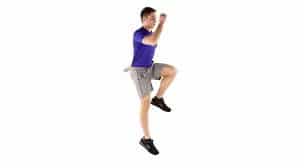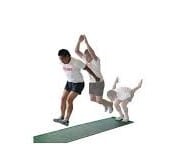
Jumping Higher Off Two Feet vs One Foot
If you are competing in basketball, volleyball, high jump or even tennis, you will ultimately find that the height of your vertical jump will not alter significantly, regardless of whether you are Jumping Off One Foot or Two.
While leaping higher is of tremendous benefit in all of these codes, you will often find that different game situations will most likely determine how many feet you use to jump - if you opt to jump at all.
If you take anything away from this blog, it should be that at the outset there is actually NO BEST way to jump! There is only a best way to jump under a given circumstance.
The Benefits of Jumping With One Foot
The most compelling aspect about jumping off one foot is that you will definitely take off from the ground considerably better than those who opt to jump off two feet.
If that is not a good enough sales pitch for you, it would also be prudent to note that jumping off one foot also creates a meaningful opportunity for your one free leg to help propel you further into the air once you have taken off from the ground.
The Benefits Of Jumping With Two Feet
All things being equal, those who opt to jump with two feet are expected to record a better vertical jump, even though that difference is seldom more than 10cm higher than average heights recorded after jumping with one foot.
Those better verticals - however small you might think they are - are a direct result of you being able to store and release more elastic energy. That boils down to basic maths, really. Two legs are more powerful than one. Because you are storing and releasing more elastic energy, you are also producing more explosive power when jumping off two feet.
How To Jump On The Move

Nothing about jumping is ever simple but in essence, there are two ways to effectively execute a running jump or a jump on the move.
Depending on the circumstances, you could execute a running jump by running in a straight line before taking off from the ground or you could be running at a curved angle before taking off from the ground.
The latter is certainly more common on the high jump truck but curved running is certainly not unique to track and field competition. In basketball you are often left with no choice but to run in at a curve, before taking off and dunking.
There are also some variations to that even, as sometimes circumstances will also dictate that you change direction right before you take off from the ground, having already completed some semblance of a run-up in an opposite direction. When it comes to sport nothing is ever linear and that is particularly relevant when jumping on the move.
When you opt to run in a straight line, before jumping, it is very common to start the movement by walking the first two or three strides. That would effectively be the build-up, as you briefly assess your surroundings.
Subsequent to the walk-in, the first two or three actual running strides will determine how well this attempt at a jump is likely to finish. If those first few running strides are not consistent, you might as well pack up shop because you are destined to crash and burn.
The only way to master this facet of jumping is constant repetition. You have to commit your muscles to remembering how to move in those initial stages of the run-up. Failure to do so means that you are unlikely to build up the velocity and gather the momentum you need to Jump Higher.
When you opt to run with a curve, before jumping, you will find yourself either leaning away from the target or leaning in towards the target at various stages of the jump movement.A classic example of this is the high, where you start the running jump with your body leaning away from the target before leaning into the horizontal bar just before you actually take off.
The movement that basketball players make is quite similar to that. Because of the defensive dynamics associated with basketball, a player is often forced to run with a slight lean away from the hoop before making final adjustments just before he takes off from the ground.
There are two things to note about the curved run. The first is that one of your legs is almost always likely to play the more supportive role while building up speed and force. Incidentally, the fewer the strides you make while running at a curve, the better off you will be at trying to gather meaningful momentum.
Depending on how strong and talented you are, that means circumstances will likely dictate that running off a curved run leaves you with no choice but to take off from one leg.
That is not to say there are no cases when people take off from two feet while jumping on the move but they are limited and the biomechanics of it are always complicated.. When it comes to sport, the less the complication, the better off you are likely to be.
When To Jump Off One Foot

It is always better to jump off one foot when you are jumping on the move. Not only are the biomechanics a lot less complicated here but we have also already established in the paragraphs above that the take-off height is generally better when jumping off one leg.
When you are jumping on the move, this leaves you well placed to compensate for whatever explosive power you might have lost without the use of the second leg.
The difference between a one-foot and two-foot jump is negligible, as it is, but there is a case to be made that you are likely to produce a better vertical off one foot, while jumping on the move.
When To Jump Off Two Feet

You are best placed to jump off two feet when you have a little more time on your hands, which will allow you to initiate an effective countermovement. You need to remember that the whole point of jumping off two feet is to generate the most explosive power possible with your body.
Because it is an awkward way to jump, there is hardly any point to jumping off two feet when you are not going to make the most of the potential advantages that come with this. You should jump off two feet when you are in close proximity to your target, where that be the net in volleyball or the hoop in basketball.
How To Improve Your Jump off One Foot
Focus your jump training regimen on exercises that are likely to improve your agility and flexibility in the lower limbs. More often than not, Plyometrics will have you completely covered in this sphere.
How To Improve Your Jump Off Two Feet
Focus your jump training regimen on exercises that are likely to increase your strength and power output in the lower limbs. Most of those will be bodyweight and weight lifting exercises.
Conclusion
The direct answer to the question in this blog is that you are most likely to jump higher when you take off from two feet, than when you take off from one foot.
However, there are biomechanics which dictate this is not always possible, when in the field of competition. A complete athlete knows how to jump well off one or two feet.
Hey, I’m Aleksandar and I am a Basketball freak! That is why I decided to create this blog. Teaching people How to dunk a basketball and How to Jump Higher in this sport or other related sports that require vertical jumping, is my specialty. If that’s your aim, then you have come to the right place.
